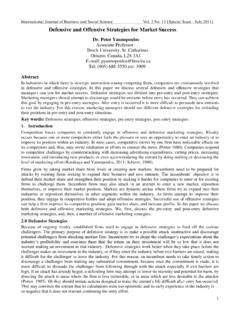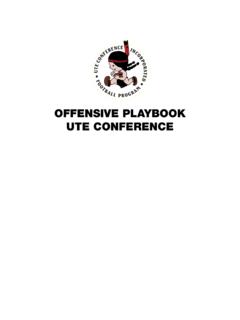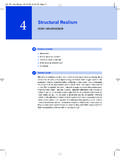Transcription of 20. OFFENSIVE TEAM TACTICS AND PRINCIPLES
1 20. OFFENSIVE TEAM TACTICSAND Team TACTICS and PrinciplesNow that we have been exposed to individual OFFENSIVE TACTICS , we should be betterprepared for the introduction of OFFENSIVE team TACTICS and TACTICSLEVEL I & IIINDIVIDUALDEFENSIVE TACTICSLEVEL IITEAM PLAY SYSTEMSSPECIAL SITUATIONSLEVEL II & TACTICSO ffensive Team Tacticsand PrinciplesLevel ITwo on One Attacks Give and Go Give and Follow Cross Pass to Open SpaceOpen Ice TACTICS Headman Wideman Backman Decoy SkatingMid-Lane SupportQuiet ZonesAttacking TACTICS One-Two-ThreeAttacks Wide RimTEAM TACTICS GOVERNING LAWS Defensive Team Tacticsand PrinciplesLevel IIDefending Two-on-Two Switching Man-to-ManCoverageDefending Two-on-One Two-on-One Middle Two-on-One Outside Prime Scoring AreaDefending One-on-two Overplay Middle One-on-TwoDefending Against aSecond WaveRiding Your CheckDefensive Your CheckDefensive Zone TACTICS Sagging Backside Coverage GOVERNING LAWS OffensivePrinciplesPressurePuck
2 ControlSupportTransitionDefensivePrincip lesPressureStall/ContainSupportTransitio nUpon completion of this chapter, you will be better prepared to: understand the basic OFFENSIVE TACTICS and PRINCIPLES governing team TACTICS , teach offesnive team TACTICS and flow chart depicting the interrelationship, between the various levels of hockey technicaldevelopment is illustrated in Table 1. As well, the key content areas for team TACTICS andprinciples are 1: Flow Chart Highlighting Team TACTICS in Designing Team Play PrinciplesPrior to presenting the OFFENSIVE team TACTICS , it will be helpful to outline theprinciples that govern such OFFENSIVE PRINCIPLES are:General laws or rules which govern and guide the application of teamtactics, systems, and example, OFFENSIVE players away from the puck must move quickly to aposition which makes them available as a passing option. Such player movementillustrate the principle of are four PRINCIPLES which govern OFFENSIVE play: pressure puck control support transitionOffensive PRINCIPLES serve to create a high percentage of scoring play begins the moment your team gains possession of the Principle #1 PressureA quick player and/or puck movement that forces the defender toreact ( , adjust one s position) more quickly than they wouldlike.
3 It creates time and space for the attacker(s).Accomplished by:SpeedA quickness to attack that will limit the reaction time of the defender (stress thedefence) and force defensive of AttackAny action or movement in a confined area which creates an OFFENSIVE IOffensive Principle #2 Puck ControlAs in all possession-oriented sports, the principle of puckcontrol is an important factor contributing to offensivesuccess. A team which is able to maintain possession of thepuck will be able to create scoring by:Puck ProtectionAny action or movement that keeps the puck away from the defender through theuse of one s body. For example, driving to the SkillsThe individual who develops quick skating strides, acceleration with the puck,drive skating, sculling, crossing over to cut in, and cutting to the net, willcontribute to a team s ability to execute effective puck Principle #3 SupportPlayers away from the puck must involve themselves as a passingoption and as part of the attack.
4 This requires that players are able toread the checking intentions and anticipate the movements of thepuck carrier in order to react by:TriangulationAny OFFENSIVE formation which creates OFFENSIVE triangles, thus providing the puckcarrier two passing options and enabling the OFFENSIVE team to create width anddepth in the LaneThis applies to the OFFENSIVE attack through the neutral zone which by passing to ateammate in the mid-lane or carrying the puck from an outside lane to the mid-lane, the puck carrier is in a position to initiate a play to either side. In theoffensive zone, the attackers will also attempt to penetrate the slot (mid-lane) for agood scoring AdvantageGood support can contribute to the pressure applied on the defence by creatingnumerical advantage and outnumbering the defenders in a confined away from the puck must be active in order to be involved in the it is desirable to outnumber the opponent in the area of the puck, it isequally desirable to have balance in your attack by filling all three lanes.
5 This willassistin stretching the defence which increases the space and time available to theattacking Principle #4 TransitionThis is defined as the ability of a team to quickly move fromdefence to offence and vice by:Counter AttackThis can be done quickly by a fast break (pressure) or in a controlled manner withpuck Team Two-on-One AttackWhen a two-on-one situation is created against a defender, a number of TACTICS canbe utilized to advance the puck past the and GoAs illustrated in Figure 1a and 1b: The puck carrier Oattempts to force the defender C to commit by threateningto attack with the puck. A teammate E moves to a position of support to create an open passing lane. The puck carrier Opasses to the teammate Eand accelerates into an openingfor a return 1a: Give and Go (Two-on-One) Defensive Zone Break IFigure 1b: Give and Go OFFENSIVE Zone AttackGive and FollowAs illustrated in Figure 2: Puck carrier Oattempts to force the defender C to adjust position bythreatening with the puck.
6 The puck carrier passes to a teammate E who has opened up a passing lane. The puck carrier moves in the direction of the pass receiver to a position ofsupport for a return pass ( , back or drop).Figure 2: Give and FollowLEVEL illustrated in Figure 3a, 3b and 3c: A cross can be initiated either by the puck carrier or a teammate. It involves an exchange of position by two OFFENSIVE players who try to isolate adefender and force a decision by the defender. It is critical that the cross forces the defender to adjust position by movinglaterally rather than diagonally. By cutting across in a flat arc the attacker is better able to protect the puck andalso prolong the decision of the defender. The puck carrier should attempt to establish an outside position initially in orderto increase the adjustment for the defender once the cross is executed. A number of options are available to the puck carrier ( , lateral feed, drop orback pass, hold puck and accelerate into opening) as a result of a 3a: CrossFigure 3b: CrossFigure 3c: Cross(Lateral Feed)(Drop After the Cross)Pass to Open SpaceThe puck carrier, by passing to open space instead of attempting a devious pass toa teammate who has arrived at a particular location, does so in such a mannerwhich is difficult for the defender to block.
7 This tactic is difficult to defendagainst and enables the pass receiver to take the puck at speed (Figure 4). The OFFENSIVE players read the checking pressure and positioning of thedefender. The player away from the puck initiates the play by attempting to move to openspace behind the defender. The puck carrier reads the movement of the second attacker and passes the puckinto this open space. A soft pass is utilized in order to ensure that the puck can be retrieved by theplayer moving to open space. The boards may also be used to get the puck toopen space ( , dumping the puck). I Passing to open space instead of attempting to complete a pass once theteammate has arrived at a particular location, the puck carrier makes it difficultfor the defender to block this passing lane. This tactic is difficult to defend against since it permits the pass receiver to takethe puck at 4a: Pass to Open SpaceFigure 4b: Pass to Open Space( OFFENSIVE Zone)(Neutral Zone) Open Ice TacticsIn open ice, a number of passing TACTICS can be used to maintain puck possession,and apply the OFFENSIVE PRINCIPLES previously described as well as the followingtactics:Headman The attack is quicker by using a headman pass to a teammate either higher inthe same zone or in an advanced zone.
8 This manoeuvre forces the defence to adjust their position by changing the pointof attack and thus opens up space offensively. It is important the attackers move quickly to support the puck A wideman pass can be used effectively in situations in which the defenders areoverloaded in the same lane as the puck carrier (Figure 5). The puck carrier either reads an overload situation or attempts to draw thechecking pressure. By moving the puck quickly to a teammate across the width of the ice, the pointof attack is changed and the receiver can now use open space to advance thepuck. Again, the defence is stretched as it attempts to adjust its position to counterthis 5a: WidemanFigure 5b: WidemanOffensive ZoneOpen IceBackman In certain situations it may be advantageous for the OFFENSIVE team to pass thepuck back in the direction of their own goal in order to maintain puck control. Once again this should result in stretching the defence, thus creating additionalspace to generate an attack.
9 This tactic also creates additional time for the OFFENSIVE team to regroup andbegin a new attack. A backman pass is often used to start a counterattack after a turnover in theneutral Skating This is a variation of the headman tactic which, again, can be used to stretch thedefence in the neutral zone (Figure 6). As the puck carrier O begins an attack from the defensive zone, a teammate 1moves quickly up the boards and cuts laterally just outside the OFFENSIVE blueline. This creates an OFFENSIVE threat which the defenders must respect by saggingdeeper, otherwise, a headman pass can be executed. By forcing defenders to retreat, additional space is created in the mid-ice zone. The defenders must then either honour this threat by backing off their own blueline or risk being caught without speed against the IFigure 6: Stretch Mid-Lane Support This tactic is particularly effective on the breakout (Figure 7). As the puck carrier O advances in an outside lane, a weakside 3 winger or aplayer away from the puck skates into the mid-lane in order to provide closeand quick support for 1.
10 In order to maintain balance in the attack, another OFFENSIVE 2 player shouldmove to fill the vacated outside 7: Mid-Lane SupportLEVEL Attacking TacticsOne-Two-Three Principle of Attack The one-two-three principle of attack respects the OFFENSIVE PRINCIPLES of puckcontrol, pressure, triangulation, and balance (Figure 8).IThe puck carrier is advancing to attack the net. This will usually take the formof a driving to the net action which forces one defender to go with the second attacker pressures the net (backside post) in order to create a passingoption for the puck carrier, or to draw the second defender deep into the third attacker takes up a trail position by slowing down and drifting towardsthe puck carrier s lane. This establishes depth to the attack and also puts thethird attacker in position to provide good defensive support if the attackingteam loses possession of the puck. A number of play options can be executed using the one-two-three principle 8: One-Two-Three Principle of Quiet Zones In order to maintain possession of the puck in the OFFENSIVE zone, the puck canbe moved to specific areas of the ice which are considered non-threatening bythe defenders.




